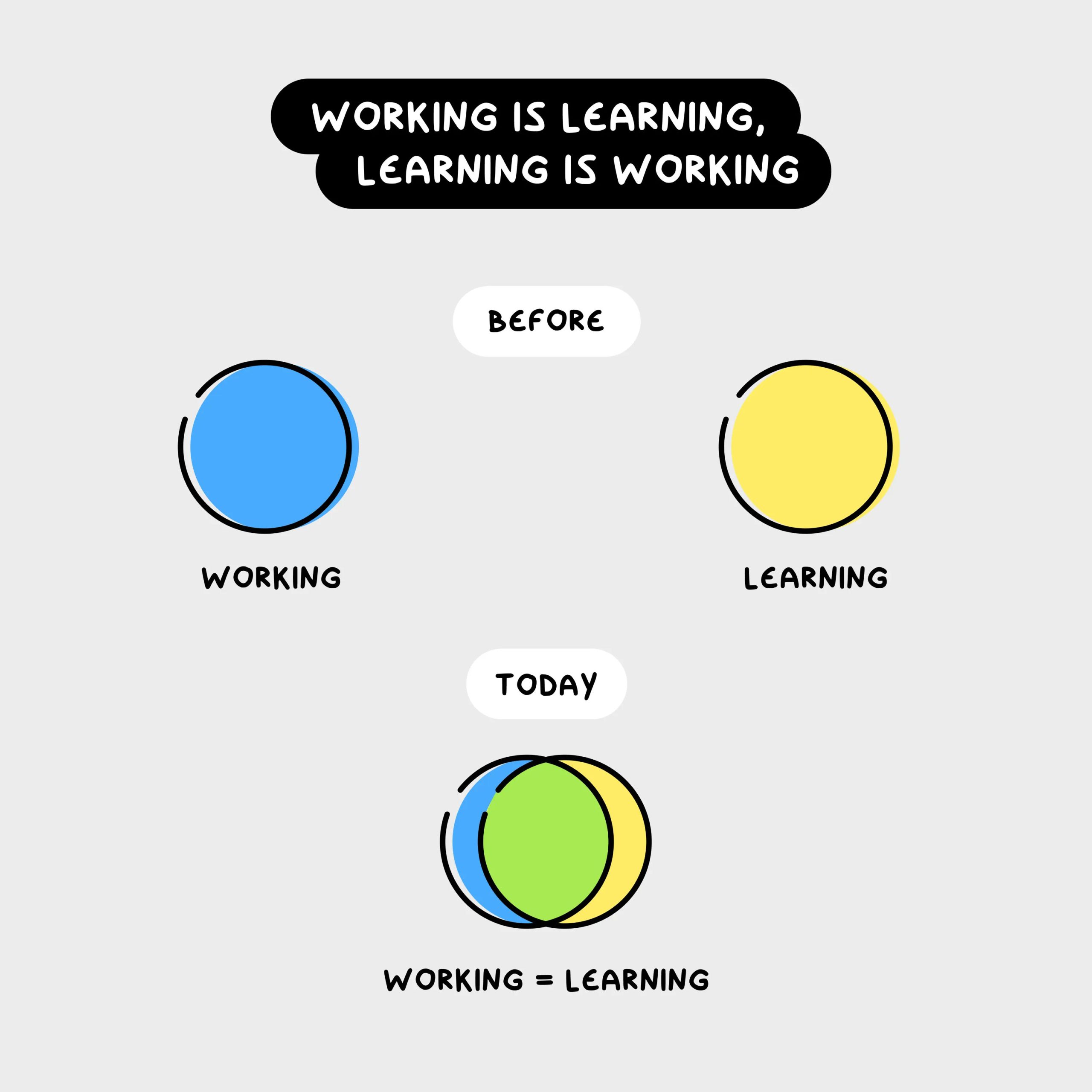
How to build a learning organization the realistic way
Creating a culture that values learning comes with many benefits for organizations. For one, the commitment to learn and apply what’s learned daily gives learning organizations a competitive edge. They’re able to quickly adapt to changing trends, which contributes to business growth and success.
And, two, learning organizations can better retain employees. In fact, 94% of employees agree they’d stay longer with a company if it’s committed to learning and development.
The problem? Without a solid strategy and successful execution, all the training investment in the world means nothing.
There are many factors involved in cultivating a productive, thriving environment for workplace learning and development. For starters, what works for one company may not work for another.
You need to get a good understanding of your team’s general learning style, research the training methods out there, and always encourage ongoing workplace learning.
In this piece, we’ll talk about how to build a learning organization while looking at inspiring examples.
Let’s start with the basics.
What is a learning organization?
A learning organization is a workplace that’s intentional about empowering its employees with the knowledge to perform their job better. In doing so, these organizations grow their workforce’s skills, equipping them to innovate faster and better handle unexpected and challenging situations. In learning organizations, working and learning go hand in hand.

(Image source: Jeff Kortenbosch)
Peter Senge popularized learning organizations in his book The Fifth Discipline, and emphasized the importance of nurturing new ideas and ways of thinking, and continually learning how to learn together.
Creating a successful learning organization takes more than just enrolling your staff in training programs. Instead, it takes a learning culture, invested leadership, and more. Let’s look at these foundational steps next.
View training as a strategic advantage rather than an expense
Good initiatives start with a clear mindset.
In terms of learning and development, leadership must be clear that it’s not an additional expense that can be cut out in a financially difficult situation.
Instead, it’s a strategic investment that delivers a huge return on investment. The first step, then, is to take learning and development (L&D) teams as strategic partners.
Not convinced yet? Take it from Chaparral Steel, one of the best learning organization examples.
The company sends its first-line supervisors on sabbaticals to countries where they visit academic and industry leaders. The aim is to learn new work techniques and practices and return with unique knowledge to apply to their daily operations.
The result? Chaparral is among the five lowest-cost steel plants out there.
Help people embrace change
Not only do leaders need to understand how learning and development can benefit them but they also need to shift their people’s mindset.
This reduces resistance to change as employees understand the organization will not remain static. And that they need to be flexible enough to grow with these changes.
An effective way to get people to embrace change is to host one-on-ones to explain the importance of embracing learning. And while you’re at it, instill the idea that learning is a daily job and a journey—not a course with defined start and end points.
Technically, this is known as on-the-job learning. It involves taking up projects that encourage learning. And it focuses on encouraging and facilitating employees to learn and apply what they learn in their daily work.
As Lisandro Morón who works as a Learning and Organizational Consultant at Implement Consulting Group, puts it:
“You learn through getting better at your work and actually implementing what you have learned.”
The best part? On the job learning solves the leading challenge that L&D faces: lack of time, which 65% of folks report is their top struggle.
Make learning part of your culture
Creating a learning culture is among the biggest challenges that L&D professionals struggle with.
Admittedly, it can be tough. But it’s not impossible. The key is to reward a growth mindset and promote an environment of continuous learning by doing.
But first, what’s a growth mindset? It’s the ‘I can’t do it yet’ attitude that sees every challenge as an opportunity to learn instead of thinking ‘I can’t do that’ when hit with a roadblock.
It’s also the mindset that takes ownership of one’s mistake. Again, this is in sharp contrast with the fixed mindset that blames others every time they fail.
So how can you promote a growth mindset in your organization?
To begin with, encourage employees to ask themselves the following questions when faced with a challenging situation:
- What can I learn?
- What can I do better next time?
- How can I adjust?
What’s more, instead of punishing failure, discuss and learn from mistakes.
At Howspace, for example, we have a Slack channel called TIFU (today I f*cked up) where people can share their mistakes and lessons learned without being chastised for them. We’ve heard of other companies’ having Monday morning oh sh*t meetings with the same agenda.
Also, be sure to push employees to become more attentive to details. Push them to go beyond diagnosing surface-level problem symptoms to access underlying causes. And to continually ask ‘why?’
Involve the L&D team within your organization early
This is yet another crucial step for building a learning organization.
Traditionally, organizations tend to do strategy work upfront, and L&D partners are invited next. This, however, is the recipe for failure.
The reason: you need to collaborate with the L&D team on understanding your employees’ learning requirements instead of assuming what training they need.
This means the correct steps are first to bring in a trainer to assess training requirements.
Say a manager brings in a trainer, asking them to help resolve conflicts among team members.
The trainer first determines the need by first talking to the team in the absence of the manager. From there, they learn that the team gets along just fine. If anything, they have a problem with the manager.
In this example, you’ll see that conflict resolution isn’t the training needed—confirming how important it is to collaborate with L&D professionals from the start to unearth the heart of the problem.
The Executive Vice President of Marketing and Business Development at Eagle’s Flight, Chris Evans, shares they take this approach too, making them one of the great learning organization examples to look up to:
“First we get the senior team aligned on what needs to happen and what it will look like when that has been achieved. The second part is what I call an inclusive discovery and customization approach: get people involved in co-creating the learning journey, so there will have a high level of ownership in learning and applying that which is taught.”
And finally, embed learning facilitators within different departments of the organization
Once ready to invest in L&D, leaders need to keep asking themselves about the strategies to have in place to enable collaborative learning.
An effective way to do so is to embed trainers within different departments where they not only impart information but also bring knowledge from other departments.
The Golden Nugget Model—as created by Howspace’s customer success manager, David Donaldson—is applicable here. It involves identifying the ‘golden nugget of wisdom’ in a training program. Let’s say there are 20 participants in a training program and the trainer is sharing advice. That’s the traditional route where the trainer gives out information—it’s self-limiting in that there is only one golden nugget in the room.
What if we shift to a trainer as facilitator model? Information is shared by inviting participants’ experiences and knowledge on the topic. It’s among these participants that you find multiple golden nuggets of wisdom. This is collaborative learning done right. Not only will we find more nuggets, but we will also build and refine those nuggets that are uncovered.
In effect, we have transitioned from a single instructor per program to multiple instructors, each all adding and learning from each other. In today’s virtual world, we can leverage collaborative platforms to enable this model.
For example, by creating an informal and collaborative learning community using a platform like Howspace you can get employees to share their mistakes and knowledge about the topic they’re learning about.
The interesting bit? Employees can share their comments, and questions anonymously. This helps remove the fear that several folks have around sharing their thoughts for fear of being singled out.
Not to mention, you can also co-create learning journeys with employees using such a collaboration platform.
For example, source employees’ comments on what to learn. Then, use Howspace’s AI features to organize, categorize, and summarize participants’ comments.
If you’re curious about how you can use Howspace to drive innovation and collaboration in your L&D programs, why not give it a try? Start for free today and unlock Howspace’s key features for you and up to 20 participants.